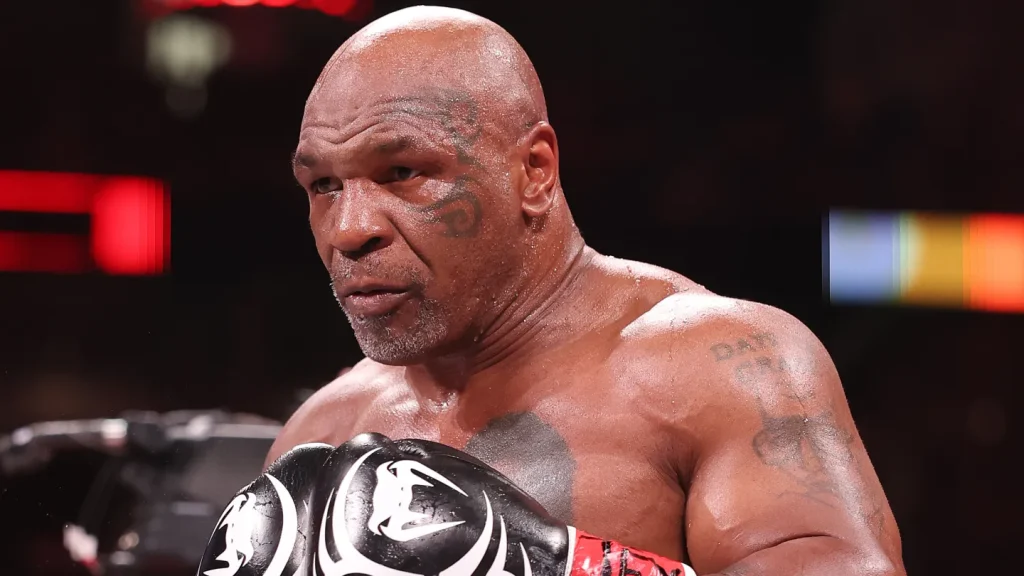Introduction: Iron Mike Returns to the Spotlight
Boxing legend Mike Tyson is making headlines again with the announcement of an exhibition bout against Floyd Mayweather scheduled for spring 2026. This comes on the heels of his November 2024 Netflix fight against Jake Paul that drew over 108 million households globally, making it the most-streamed sporting event in history.
While the 59-year-old Tyson may no longer possess the explosive speed that defined his prime, his fighting legacy—particularly his mastery of the peek-a-boo boxing style—continues to fascinate combat sports enthusiasts worldwide. This comprehensive technical breakdown explores the defensive system that transformed a 5’10” heavyweight into one of the most feared fighters in boxing history.
What is the Peek-a-Boo Boxing Style? Understanding Cus D’Amato’s Revolutionary System
The peek-a-boo style (also called “tight defense boxing”) is a defensive-offensive system developed by legendary trainer Cus D’Amato. Unlike traditional boxing stances, this technique emphasizes aggressive counter-punching combined with impenetrable defense—a perfect marriage that created boxing’s most devastating inside fighters.
Origins and Philosophy
D’Amato didn’t invent the peek-a-boo for Tyson. Before Iron Mike, the system propelled Floyd Patterson to become an Olympic gold medalist and the youngest heavyweight champion before Tyson (read more about boxing history at the International Boxing Hall of Fame). Jose Torres, another D’Amato protégé, also achieved championship success using peek-a-boo principles.
D’Amato’s core philosophy was simple yet profound: “The punch you don’t see is the punch that knocks you out.” The peek-a-boo style was engineered to make opponents miss while creating devastating counter-punch opportunities.
The Technical Foundation: Breaking Down Mike Tyson’s Peek-a-Boo Stance
1. The High Guard Position
The peek-a-boo’s most recognizable feature is its defensive shell:
- Gloves positioned at cheek level, creating a fortress protecting the face
- Elbows tucked tight to the ribcage, guarding against body shots
- Chin buried deep into the chest, minimizing target exposure
- Constant vigilance through the small gap between gloves (hence “peek-a-boo”)
This wasn’t passive defense. The high guard meant Tyson’s hands were perpetually loaded and ready to fire rapid combinations without telegraph.

2. The Crouch: Lowering the Center of Gravity
Tyson fought from an extreme low crouch, bending at the knees and waist. This compressed stance provided three critical advantages:
Smaller Target: Made Tyson’s head harder to locate, forcing opponents to punch downward at awkward angles.
Explosive Power Generation: By staying low, Tyson could explode upward through his legs and hips, generating tremendous power in his uppercuts and hooks. His knockout power originated from the ground up, not just arm strength.
Superior Balance and Mobility: The wide stance and low positioning gave Tyson exceptional balance, allowing instantaneous directional changes while maintaining punching power.
Advanced Movement Patterns: The Bobbing and Weaving Symphony
Head Movement Mastery
What separated Tyson from other defensive fighters was his mesmerizing head movement. He employed constant, rhythmic bobbing and weaving—side to side, up and down—creating a three-dimensional puzzle for opponents.
The peek-a-boo system emphasized slipping punches by millimeters. Tyson didn’t lean away from punches; he slipped inside them, using minimal movement to make opponents miss while staying close enough to counter immediately.
Footwork and Angle Creation
Despite his compact 5’10” frame, Tyson was exceptionally quick on his feet. His footwork followed specific patterns:
- Lateral slides: Quick side-to-side steps moving off opponents’ centerlines
- Pivot steps: Sharp pivots creating new angles after throwing combinations
- Forward pressure: Relentless advancement giving opponents no rest or escape routes
The genius was in how these movements synchronized. Tyson would bob and weave to make an opponent miss, step inside, pivot to create a new angle, then explode with combinations before opponents could reset.
The Offensive Arsenal: Power Punching from the Peek-a-Boo System
Inside Fighting: Tyson’s Danger Zone
The peek-a-boo style was designed to get Tyson inside—into phone-booth range where his shorter arms became an advantage. Once inside, Tyson became a surgeon with a sledgehammer.

Signature Combinations:
- Left hook to the body: After slipping an opponent’s jab, Tyson would step inside and rip devastating hooks to the liver or ribs
- Hook-uppercut combinations: When opponents protected their body, Tyson immediately went upstairs with hooks and uppercuts
- Double and triple hooks: Rapid-fire hooks thrown in succession, each generating power from legs and hip torque
Learn more about boxing combinations and techniques at USA Boxing.
Counter-Punching Excellence
While perceived as purely aggressive, the peek-a-boo style is fundamentally a counter-punching system. D’Amato taught Tyson to make opponents commit first, then exploit openings.
- Jab counters: Slip left or right, counter with left hook or overhand right
- Right-hand counters: Duck under, come up with uppercuts
- Every defensive movement creates offensive opportunity
Breaking News: Mike Tyson vs Floyd Mayweather 2026
The boxing world was rocked in September 2025 when Mike Tyson and Floyd Mayweather announced they’ve signed contracts for an exhibition bout in spring 2026. While details on date, location, and television partner haven’t been released, both Hall-of-Fame boxers expressed excitement.
“I still can’t believe Floyd wants to really do this,” Tyson stated. “It’s going to be detrimental to his health, but he wants to do it, so it’s signed and it’s happening!”
Promoters predict the fight could break every boxing broadcast and streaming record, following the massive success of the Jake Paul fight. Read the full announcement at CBS Sports and ESPN Boxing.
Tyson’s Recent Return: The Jake Paul Fight
In November 2024, Tyson faced YouTuber-turned-boxer Jake Paul at AT&T Stadium in Arlington, Texas, losing via unanimous decision. Fighting in front of 72,300 fans, Paul controlled most of the fight with judges scoring 80-72, 79-73, and 79-73.
The bout featured modified rules due to Tyson’s age: eight two-minute rounds instead of standard three-minute rounds, and heavier gloves to reduce punch impact. While Tyson didn’t showcase the peek-a-boo brilliance of his prime, the event demonstrated the enduring fascination with Iron Mike’s legacy.
The Psychological Dimension: Fear as a Weapon
The technical aspects were devastating enough, but Tyson weaponized psychology uniquely. His ring walk—no robe, no socks, just black trunks and menace—set the tone. The peek-a-boo stance amplified intimidation, with Tyson glaring through his gloves like a caged predator.
Many opponents were beaten before the first bell. They’d seen the highlight reels of Tyson’s first-round knockouts. The peek-a-boo style made him look simultaneously defensive and ready to explode—a psychological paradox keeping opponents mentally off-balance.

Physical Requirements: Why Not Everyone Can Master Peek-a-Boo
The peek-a-boo style’s effectiveness was deeply tied to specific physical attributes:
Essential Physical Traits
- Exceptional Neck Strength: Constant bobbing, weaving, and absorbing punches on the high guard required tremendous neck musculature
- Quick-Twitch Muscle Fibers: Explosive movements from defense to offense demanded elite fast-twitch muscle development
- Elite Cardiovascular Conditioning: Maintaining high-intensity movement patterns required world-class conditioning. When Tyson’s conditioning slipped in later years, the style’s effectiveness diminished dramatically
- Natural Timing and Reflexes: Split-second decision-making to slip punches by millimeters and counter immediately couldn’t be fully taught—it required innate talent
- Ambidextrous Power: Tyson was naturally ambidextrous, equally capable of devastating knockouts with either hand
The Evolution and Decline: From Champion to Celebrity Boxer
The Prime Years (1986-1990)
In his prime, Tyson’s peek-a-boo execution was nearly flawless. He became the youngest heavyweight champion in history at 20 years old, destroying opponents with terrifying efficiency. Nineteen of his first 22 professional wins came by first or second-round knockout.
His most devastating knockouts using peek-a-boo principles included:
- Trevor Berbick (1986) – Won heavyweight title
- Michael Spinks (1988) – 91-second destruction
- Carl Williams (1989) – Brutal first-round KO
The Technical Decline
After D’Amato’s death in 1985 and Tyson’s split from trainer Kevin Rooney in 1988, the technical discipline began eroding. Tyson started:
- Abandoning constant head movement
- Standing more upright
- Relying on raw power over technique
- Neglecting the defensive fundamentals
The peek-a-boo system requires absolute commitment—half-measures don’t work. By his losses to Buster Douglas (1990) and Evander Holyfield (1996), Tyson had largely abandoned the style’s fundamentals.
Modern Relevance: The Peek-a-Boo Legacy in Contemporary Boxing
Today, the peek-a-boo style is rarely seen in pure form. The physical and mental demands are too high for most fighters. However, elements have been incorporated into modern boxing training:
- Tight guard positioning
- Emphasis on head movement
- Inside fighting techniques
- Counter-punching principles
Current Fighters Using Peek-a-Boo Elements
While no modern heavyweight fully replicates Tyson’s peek-a-boo mastery, fighters like Tyson Fury and Oleksandr Usyk incorporate elements of the defensive shell and head movement into their arsenals.
Young fighters studying Tyson’s 1980s footage can learn:
- The importance of positioning
- The power of making opponents miss by inches
- How defensive excellence creates offensive opportunities
For more on modern boxing techniques, visit Boxing News 24 and The Ring Magazine.
SEO Keywords Summary: Understanding Tyson’s Boxing Style
Primary Keywords:
- Mike Tyson peek-a-boo style
- Peek-a-boo boxing technique
- Cus D’Amato training system
- Mike Tyson fighting style
- Iron Mike boxing defense
Secondary Keywords:
- Tyson vs Mayweather 2026
- Mike Tyson Jake Paul fight
- Boxing defensive techniques
- Heavyweight boxing styles
- Counter-punching boxing
- Inside fighting techniques
- Head movement boxing
- Boxing footwork drills
Long-tail Keywords:
- How to fight like Mike Tyson
- What is the peek-a-boo boxing style
- Mike Tyson training techniques
- Best boxing defensive systems
- Peek-a-boo style advantages and disadvantages
Training the Peek-a-Boo: Essential Drills and Exercises
For Aspiring Boxers
If you’re interested in incorporating peek-a-boo elements into your boxing:
- Shadow Boxing: Practice the high guard stance, head movement, and combinations
- Heavy Bag Work: Focus on explosive power and speed with proper form
- Slip Ball Training: Develop timing and head movement precision
- Sparring: Apply peek-a-boo techniques in controlled environments
- Strength and Conditioning: Build neck strength, core power, and cardiovascular endurance
Check out training programs at USA Boxing Gyms or explore online resources at Precision Striking.
Disadvantages of the Peek-a-Boo Style: Why It’s Not for Everyone
While devastating in Tyson’s hands, the peek-a-boo has significant limitations:
Physical Demands
- Requires exceptional power – Without knockout ability, the style’s effectiveness diminishes
- Demands a strong chin – Slipping outside punches (rather than rolling with them) increases knockout risk if caught
- Needs superior conditioning – The constant movement is exhausting; fatigue destroys the system
- Size considerations – Designed for shorter fighters overcoming reach disadvantages
Strategic Limitations
- Must fight going forward – Limits tactical flexibility
- Vulnerable to disciplined boxers – Opponents who maintain distance and use jabs effectively can neutralize the style
- Requires perfect execution – No room for half-measures or lazy technique
For deeper analysis, read expert opinions at Expert Boxing.

The Tyson-Mayweather Matchup: Styles Analysis
The upcoming 2026 exhibition between Tyson and Mayweather represents a fascinating clash of philosophies:
Mike Tyson (Peek-a-Boo):
- Aggressive pressure fighter
- Seeks inside fighting range
- Power-based destruction
- Defensive shell with explosive offense
Floyd Mayweather (Defensive Counter-Puncher):
- Elusive, defensive master
- Controls distance with footwork
- Precision-based point fighting
- Shoulder roll defense
At ages 59 and 48 respectively, both fighters are far from their primes, but the stylistic contrast promises an intriguing spectacle. Learn more about Mayweather’s style at The Sweet Science.
The Perfect Storm That Created a Legend
Mike Tyson’s peek-a-boo style wasn’t just a fighting technique—it was a complete combat system leveraging his physical gifts, masking his limitations, and creating a mystique transcending sports.
When all elements aligned—D’Amato’s tactical genius, Tyson’s physical attributes, iron discipline, and perfect timing—the result was a fighter operating on a different plane. Punches that should have landed missed by fractions. Defensive movements seamlessly became devastating attacks. Opponents entered as world-class athletes and left as cautionary tales.
As Mike Tyson prepares for his exhibition bout against Floyd Mayweather in spring 2026, combat sports fans are reminded that when “Iron Mike” was at his peak, employing the peek-a-boo style with devastating precision, he was a force of nature unlike anything the heavyweight division had seen before—or has seen since.
The peek-a-boo predator was born from innovation, refined through obsessive practice, and unleashed with terrifying precision. While we may never see another fighter execute the style with Tyson’s lethal perfection, his legacy ensures that the peek-a-boo system will forever be studied, respected, and remembered as one of boxing’s most unique and effective fighting philosophies.
#MikeTyson #PeekABooBoxing #IronMike #Boxing #BoxingStyle #CusDAmato #BoxingTechnique #BoxingTraining #HeavyweightBoxing #CounterPunching #BoxingDefense #FightAnalysis #BoxingHistory


